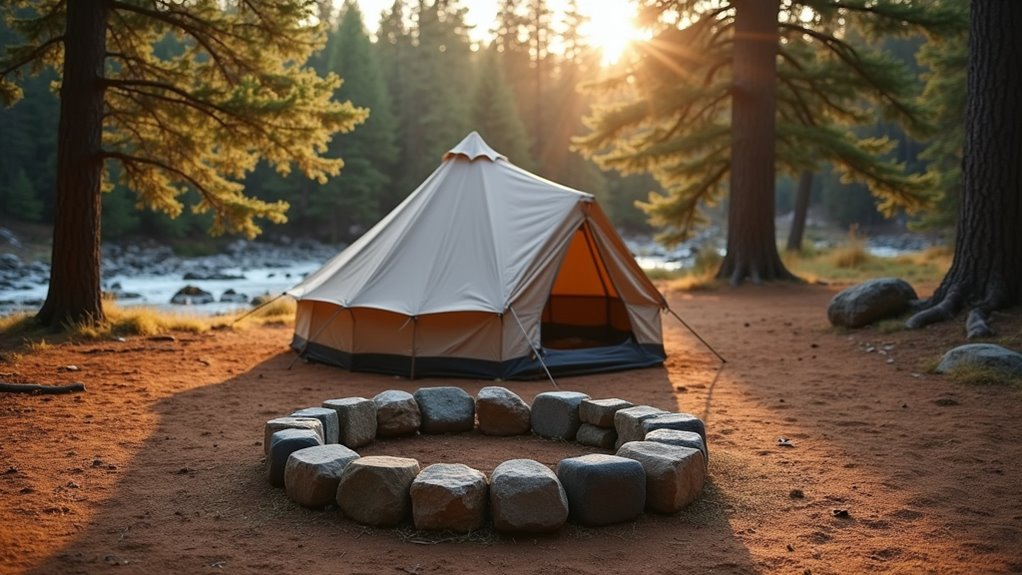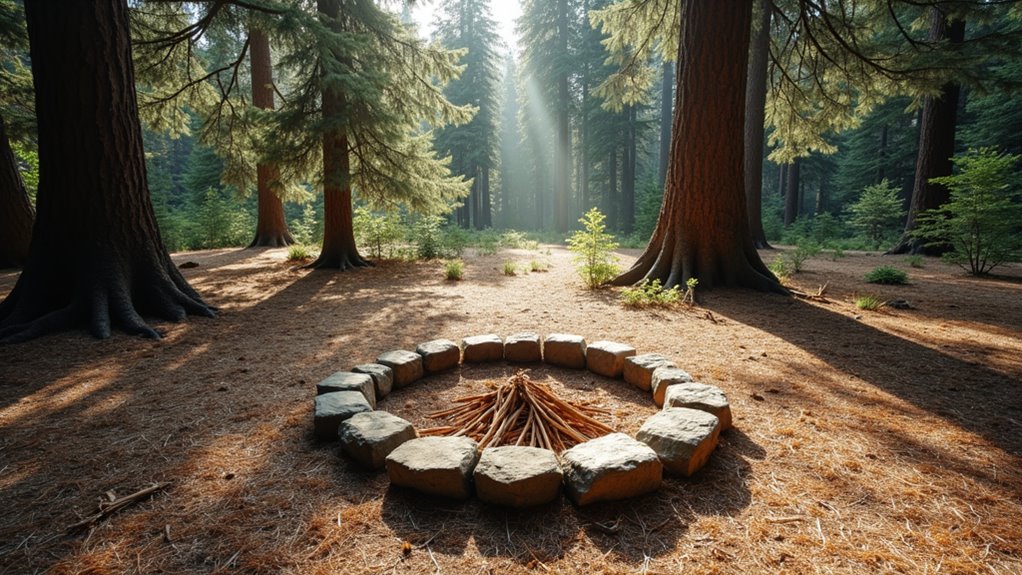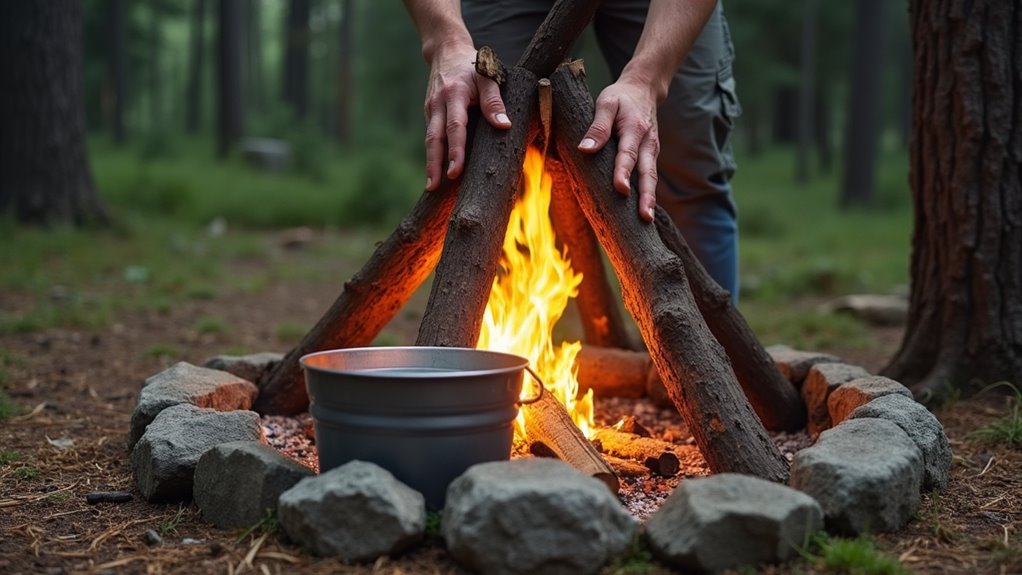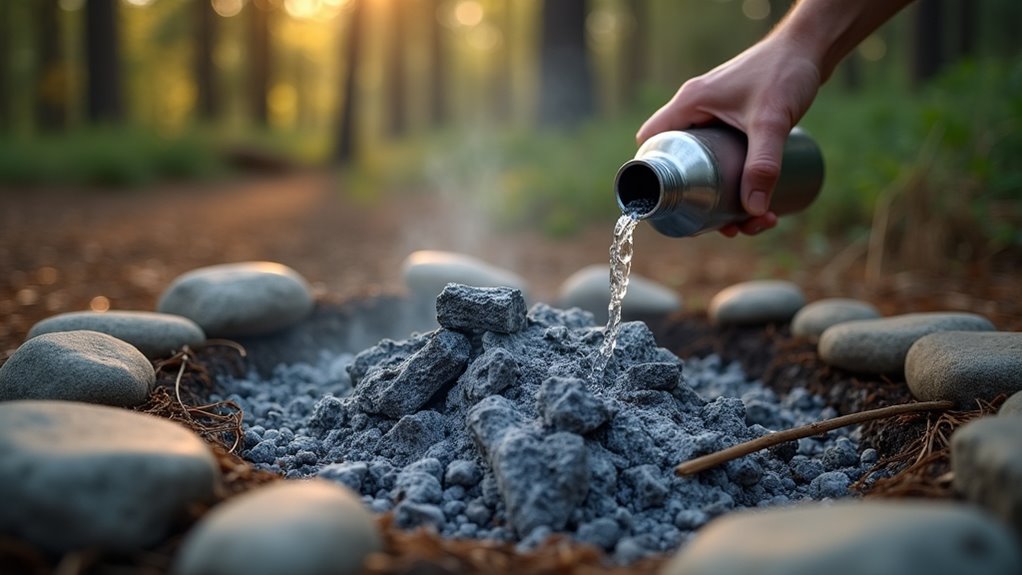Physical Address
304 North Cardinal St.
Dorchester Center, MA 02124
Physical Address
304 North Cardinal St.
Dorchester Center, MA 02124

Proper campfire techniques prevent dangerous mistakes that could endanger your group—discover the critical skills most campers dangerously overlook.
You’ve probably watched countless campfires crackle to life, but most campers make critical mistakes that could endanger their entire group. Building a proper campfire isn’t just about throwing logs together and striking a match—it’s a skill that separates experienced outdoors enthusiasts from weekend warriors. The difference between a safe, efficient fire and a potential disaster often comes down to a few essential techniques that you’ll want to master before your next adventure.

Before you even gather your first piece of kindling, you’ll need to scout out the ideal spot for your campfire. Look for established fire rings or designated fire areas first—they’re already cleared and approved for safe burning.
Scout established fire rings before gathering kindling—they’re pre-cleared and approved for safe campfire burning.
If you’re creating a new spot, choose level ground that’s at least fifteen feet from tents, trees, and overhanging branches. Clear away dry leaves, grass, and debris in a ten-foot radius around your fire site.
Avoid windy areas where sparks could spread, and stay away from rocky overhangs that might crack from heat. You’ll want easy access to water for extinguishing your fire later.
Check local fire restrictions and obtain required permits before lighting anything. Remember, the right location prevents forest fires and keeps everyone safe.
Just like researching whether to rent or buy equipment for outdoor adventures, proper planning ensures you make the best decision for your specific camping needs.
Once you’ve secured your perfect fire location, it’s time to collect the three types of fuel that’ll make your campfire a success: tinder, kindling, and firewood.
Start with tinder – dry grass, birch bark, pine needles, or shredded paper. You’ll need enough to fill your cupped hands.
Next, gather pencil-thin to thumb-thick kindling from dead branches. Collect twice as much as you think you’ll need.
For firewood, choose seasoned hardwoods like oak or maple that burn longer and hotter than softwoods. Split logs burn more efficiently than whole ones.
Always collect firewood from the ground – never break branches from living trees.
Keep everything dry by storing materials under tarps or in your vehicle. Wet fuel creates smoke and frustration.
When gathering materials in wooded areas, take precautions to avoid tick bites by wearing long pants and checking yourself regularly.

After gathering your materials, you’ll need to create a safe workspace that protects both you and the surrounding environment. Choose a spot that’s at least 15 feet away from tents, overhanging branches, and dry vegetation.
Safety starts with location—keep your fire pit at least 15 feet from tents, branches, and anything flammable.
Clear a 10-foot diameter circle down to bare soil, removing leaves, grass, and debris that could catch fire.
If there’s no existing fire ring, create one using rocks about the size of footballs. Don’t use river rocks or stones from wet areas—they can explode when heated.
Dig a shallow depression in the center, about 6 inches deep.
Keep a bucket of water, sand, or dirt nearby for emergencies.
Check local fire restrictions and weather conditions before lighting.
Wind speeds above 10 mph make fires dangerous and unpredictable.
These precautions become even more critical during winter RV camping when dry conditions and unpredictable weather patterns can increase fire risks.
With your fire site properly prepared, you’re ready to build your campfire using the proven layering method. This technique ensures consistent ignition and steady burning by arranging materials from smallest to largest.
Follow these essential steps for successful fire building:
You’ll have a roaring campfire within minutes using this methodical approach.

How do you keep your campfire burning steadily while preventing it from becoming a hazard? You’ll need to monitor your fire constantly and add fuel gradually. Feed it small to medium-sized pieces rather than large logs that’ll create uncontrollable flames.
Keep water or dirt nearby for emergencies. Never leave your fire unattended, even briefly. Wind can scatter sparks quickly, so position yourself to watch for flying embers.
Control the fire’s size by spacing out fuel additions. Remove partially burned wood if flames grow too high.
Create a safe perimeter by clearing flammable materials within ten feet.
When you’re ready to sleep or leave, start extinguishing early. Pour water slowly, stir ashes, add more water, then stir again until everything’s cold. Following these essential campfire safety practices will help ensure your outdoor experience remains both enjoyable and secure.
Beyond keeping your fire safe and controlled, you’ll want to maximize its cooking and heating potential. Smart fire management transforms your campfire from basic warmth into an efficient outdoor kitchen and heating system.
Here are four essential tips for maximum efficiency:
You’ll achieve better results with less effort. These campfire cooking techniques are fundamental skills that every tent camping beginner should master before their first outdoor adventure.

When your camping adventure winds down, extinguishing your fire completely isn’t just courteous—it’s essential for preventing wildfires and protecting the environment.
Start by letting wood burn down to ash. Pour water slowly over the embers, stirring with a shovel or stick. Add more water and stir again until everything’s cold to the touch. Never bury coals with dirt or sand—they can stay hot for hours.
Follow Leave No Trace principles by scattering cold ashes over a wide area, away from camp. If you used an established fire ring, clean it out completely. For pristine areas, dismantle your fire ring and scatter rocks naturally.
Pack out any trash, including charred food scraps. The goal is leaving your campsite better than you found it.
Teaching these responsible fire practices to children during family adventures like river rafting trips helps instill lifelong outdoor ethics and environmental stewardship.
Like Prometheus bringing fire to humanity, you’ve now mastered this ancient skill that transforms wilderness into home. Your carefully built campfire becomes the heart of camp—a beacon that draws stories, warmth, and connection from the darkness. Remember, with great power comes great responsibility. Always douse those embers completely and pack out every trace. You’ll leave only footprints behind while carrying forward memories that’ll burn bright long after the last spark dies.